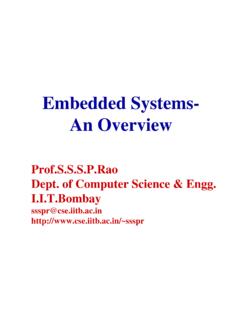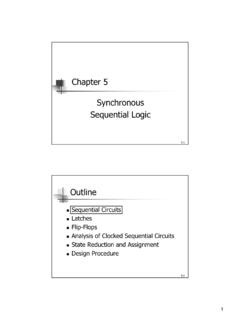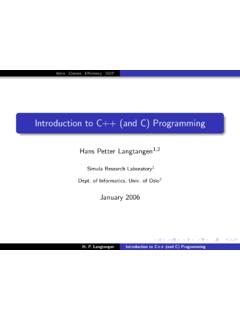Transcription of Scilab - IIT Bombay
1 ScilabA Hands on IntroductionbySatish Annigeri of Civil Bhoomaraddi College of Engineering & Technology, 2009 Table of 1 Scilab 1 Scilab 2 The Workspace and Working 2 The Workspace and Working 3 Matrix 3 Matrix 4 4 5 6 Plotting 7 Plotting 3D 8 Scilab Programming 9 Script Files and Function 10 Functions in 11 File 12 Reading Microsoft Excel 13 Some Miscellaneous 14 Mini TutorialiPrefaceScilab is a software for numerical mathematics and scientific visualization. It is capable of interactive calculations as well as automation of computations through programming. It provides all basic operations on matrices through built-in functions so that the trouble of developing and testing code for basic operations are completely avoided. Its ability to plot 2D and 3D graphs helps in visualizing the data we work with. All these make Scilab an excellent tool for teaching, especially those subjects that involve matrix operations.
2 Further, the numerous toolboxes that are available for various specialized applications make it an important tool for research. Being compatible with matlab , all available matlab M-files can be directly used in Scilab . Scicos, a hybrid dynamic systems modeler and simulator for Scilab , simplifies simulations. The greatest features of Scilab are that it is multi-platform and is free. It is available for many operating systems including Windows, Linux and MacOS X. More information about the features of Scilab are given in the can help a student understand all intermediate steps in solving even complicated problems, as easily as using a calculator. In fact, it is a calculator that is capable of matrix algebra computations. Once the student is sure of having mastered the steps, they can be converted into functions and whole problems can be solved by simply calling a few functions. Scilab is an invaluable tool as solved problems need not be restricted to simple examples to suit hand is not the aim of this tutorial to be an exhaustive and in-depth look into Scilab .
3 Instead, it attempts to get a novice started with the least fuss and is aimed at anyone who intends to start learning to use Scilab entirely on her this revision of the tutorial, exercises have been added to point the student to those aspects that were not explicitly covered by the tutorial and lead the student towards self-discovery and goes without saying that my first indebtedness is to the developers of Scilab and the consortium that continues to develop it. I must also thank Dr. Raju, E&EE Department, BVBCET, Hubli who first introduced me to Scilab and forever freed me from using 2009 Satish AnnigeriScilab TutorialiiIntroductionScilab is a scientific software package for numerical computations providing a powerful open computing environment for engineering and scientific applications. Developed since 1990 by researchers from INRIA (French National Institute for Research in Computer Science and Control, ) and ENPC (National School of Bridges and Roads, ), it is now maintained and developed by Scilab Consortium ( ) since its creation in May freely and open source through the Internet since 1994, Scilab is currently being used in educational and industrial environments around the includes hundreds of mathematical functions with the possibility to add interactively functions from various languages (C, ).
4 It has sophisticated data structures (including lists, polynomials, rational functions, linear ), an interpreter and a high level programming has been designed to be an open system where the user can define new data types and operations on these data types by using number of toolboxes are available with the system: 2-D and 3-D graphics, animation Linear algebra, sparse matrices Polynomials and rational functions Simulation: ODE solver and DAE solver Scicos : a hybrid dynamic systems modeler and simulator Classic and robust control, LMI optimization Differentiable and non-differentiable optimization Signal processing Metanet: graphs and networks Parallel Scilab using PVM Statistics Interface with Computer Algebra (Maple, MuPAD) Interface with Tcl/Tk And a large number of contributions for various works on most Unix systems including GNU/Linux and on Windows 9X/NT/2000/XP. It comes with source code, on-line help and English user manuals.
5 Binary versions are of its features are listed below: Basic data type is a matrix, and all matrix operations are available as built-in operations. Has a built-in interpreted high-level programming language. Graphics such as 2D and 3D graphs can be generated and exported to various formats so that they can be included into the left is a 3D graph generated in Scilab and exported to GIF format and included in the document for presentation. Scilab can export to Postscript and GIF formats as well as to Xfig (popular free software for drawing figures) and LaTeX (free scientific document preparation system) file TutorialIntroduction|1 Tutorial 1 Scilab EnvironmentWhen you start up Scilab , you see a window like the one shown in Fig. 1 below. The user enters Scilab commands at the prompt (-->). But many of the commands are also available through the menu at the top. The most important menu for a beginner is the Help menu.
6 Clicking on the Help menu opens up the Help Browser, showing a list of topics on which help is available. Clicking on the relevant topic takes you to hyperlinked documents similar to web pages. The Help Browser has two tabs Table of Contents and Search. Table of Contents contains an alphabetically arranged list of topics. To see the list of functions available in Scilab , search for Elementary Functions in the contents page of Help Browser. Other useful functions may be available under different headings, such as, Linear Algebra, Signal Processing, Genetic Algorithms, Interpolation, Metanet, Optimization and Simulation, Statistics, Strings, Time and Date etc. Use the Search tab to search the help for string on specific commands can also be accessed directly from the command line instead of having to navigate through a series of links. Thus, to get help on the Scilab command inv , simply type the following command at the prompt.
7 This is useful when you already know the name of the function and want to know its input and output arguments and learn how to use >help invScilab can be used as a simple calculator to perform numerical calculations. It also has the ability to define variables and store values in them so that they can be used later. This is demonstrated in the following examples:-->2+3ans = >2/3ans =.6666667-->2^3ans = >a=2a = >b= = >c=a+bc = >pi=atan( )*4pi = >sin(pi/4)ans = >exp( )ans = the answer of a calculation is stored in a variable so that it could be used later. If you do not explicitly supply the name of the variable to store the answer, Scilab uses a variable named ans to store such could enter more than one command on the same line by separating the commands by semicolons (;). The semicolon suppresses echoing of intermediate results. Try the command -->a=5;-->_and you will notice that the prompt reappears immediately without echoing a= TutorialTutorial 1 Scilab Environment|2 Fig.
8 Scilab environmentFig. Scilab help browserExercise 1 Scilab are the other ways of obtaining online help in Scilab , other than typing help at the command prompt? (Ans: From the menu ? Scilab Help or press F1 key) are the demo programs that demonstrate Scilab 's capabilities? (Ans: Go to the menu ? Scilab Demos) can you find user contributed documents on using and applying Scilab ? What are the categories for these documents? Which categories interest you? (Ans: Go to the menu ? Weblinks Contributions) can you search for a word or pattern in the Scilab online help browser? you use the built-in variable ans in your calculations? If so, is it a good idea to do so or is it better to use your own named variables? do you think it is useful to use the semicolon (;) to suppress the output of a Scilab statement? are the rules for choosing names for variables in Scilab ? Can you use a numeric character as the first character? Can you use underscore ( _ ) as the first character?
9 Can you use special characters, such as -, +, /, ? in a variable name? you change the font used by Scilab ? (Ans: Go to the menu Preferences -> Choose Font) is the command to clear the screen? (Ans: clc) is the short cut key to clear the screen? (Ans: F2 key) is command history? What are the shortcut keys to use the command history?(Ans: Go to the menu Edit History. You can also use the arrow keys) areas within your proposed branch of specialization where Scilab can be a useful there a command to record all commands that you type and save them to a file so that you can see them later? (Ans: Type help diary) you describe some useful application of the diary command? you customize Scilab startup to suit your specific needs? (Ans: To customize Scilab at start up, create a file C:\Documents and Settings\<User>\ Scilab \ Scilab -<version>\ and put any valid Scilab commands in it that you wish Scilab to execute each time it starts up.)
10 <User> must be replaced with your login name and Scilab <version> currently is so that the folder name is The above location is for Microsoft Windows XP. For Windows Vista, use C:\Users\<User>\AppData\Roaming\ Scilab \< Scilab -<version>\ ). Scilab TutorialExercise 1 Scilab Environment|3 Tutorial 2 The Workspace and Working DirectoryWhile the Scilab environment is the visible face of Scilab , there is another that is not visible. It is the memory space where all variables and functions are stored, and is called the Workspace. Many a times it is necessary to inspect the workspace to check whether or not a variable or a function has been defined. The following commands help the user in inspecting the memory space: who, whos and who_user(). Use the online help to learn more about these who command lists the names of variables in the Scilab workspace. Note the variable names preceded by the % symbol. These are special variables that are used often and therefore predefined by Scilab .










